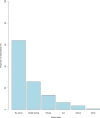How do women prepare for pregnancy in a low-income setting? Prevalence and associated factors
- PMID: 35286337
- PMCID: PMC8920258
- DOI: 10.1371/journal.pone.0263877
How do women prepare for pregnancy in a low-income setting? Prevalence and associated factors
Abstract
Background: Despite growing evidence of pregnancy preparation benefits, there is little knowledge on how women in developing countries prepare for pregnancy and factors influencing their preparedness for pregnancy. Here, we determine how women in Malawi prepare for pregnancy and factors associated with pregnancy preparation.
Methods: We used data from a previous cohort study comprising 4,244 pregnant mothers, recruited between March and December 2013 in Mchinji district, Malawi. Associations of pregnancy preparation with socio-demographic and obstetric factors were tested for using mixed effects ordinal regression, with the likelihood ratio and Wald's tests used for variable selection and independently testing the associations.
Results: Most mothers (63.9%) did not take any action to prepare for their pregnancies. For those who did (36.1%), eating more healthily (71.9%) and saving money (42.8%) were the most common forms of preparation. Mothers who were married (adjusted odds-ratio (AOR 7.77 (95% CI [5.31, 11.25]) or with no or fewer living children were more likely to prepare for pregnancy (AOR 4.71, 95% CI [2.89,7.61]. Mothers with a period of two to three years (AOR 2.51, 95% CI [1.47, 4.22]) or at least three years (AOR 3.67, 95%CI [2.18, 6.23]) between pregnancies were more likely to prepare for pregnancy than women with first pregnancy or shorter intervals. On the other hand, teenage and older (≥ 35 years old) mothers were less likely to prepare for pregnancy (AOR 0.61, 95%CI [0.47, 0.80]) and AOR 0.49 95%CI [0.33, 0.73], respectively).
Conclusion: While preconception care may not be formally available in Malawi, our study has revealed that over a third of mothers took some action to prepare for pregnancy before conception. Although this leaves around two thirds of women who did not make any form of pregnancy preparation, our findings form a basis for future research and development of a preconception care package that suits the Malawian context.
Conflict of interest statement
The authors have declared that no competing interests exist.
Figures
References
-
- WHO. Meeting to develop a global consensus on preconception care to reduce maternal and childhood mortality and morbidity. WHO Headquarters, Geneva Meeting report Geneva. 2012;78.
-
- Alkema L, Chou D, Hogan D, Zhang S, Moller AB, Gemmill A, et al.. Global, regional, and national levels and trends in maternal mortality between 1990 and 2015, with scenario-based projections to 2030: A systematic analysis by the un Maternal Mortality Estimation Inter-Agency Group. The Lancet. 2016;387(10017):462–74. - PMC - PubMed
Publication types
MeSH terms
Grants and funding
LinkOut - more resources
Full Text Sources
Medical


